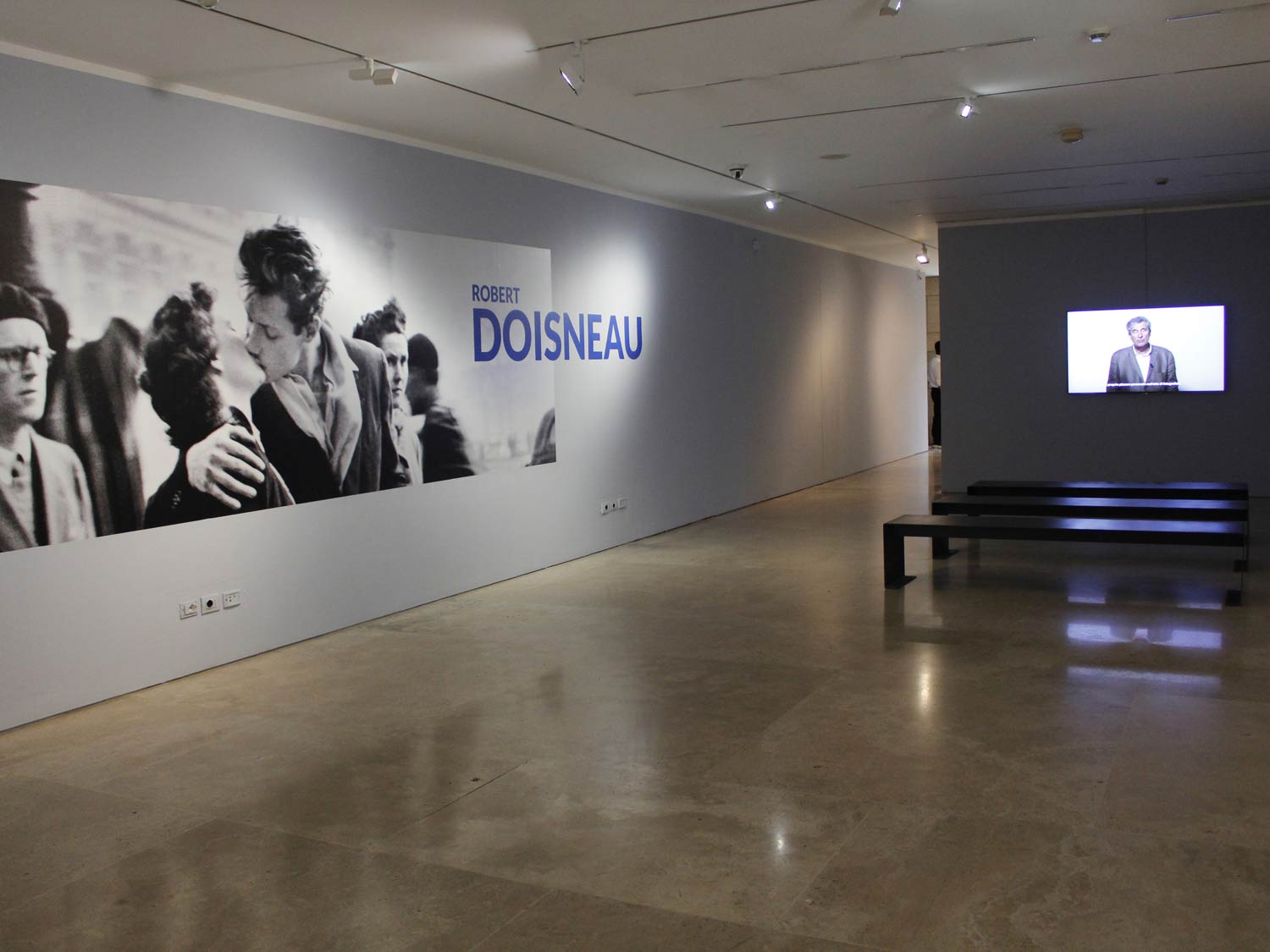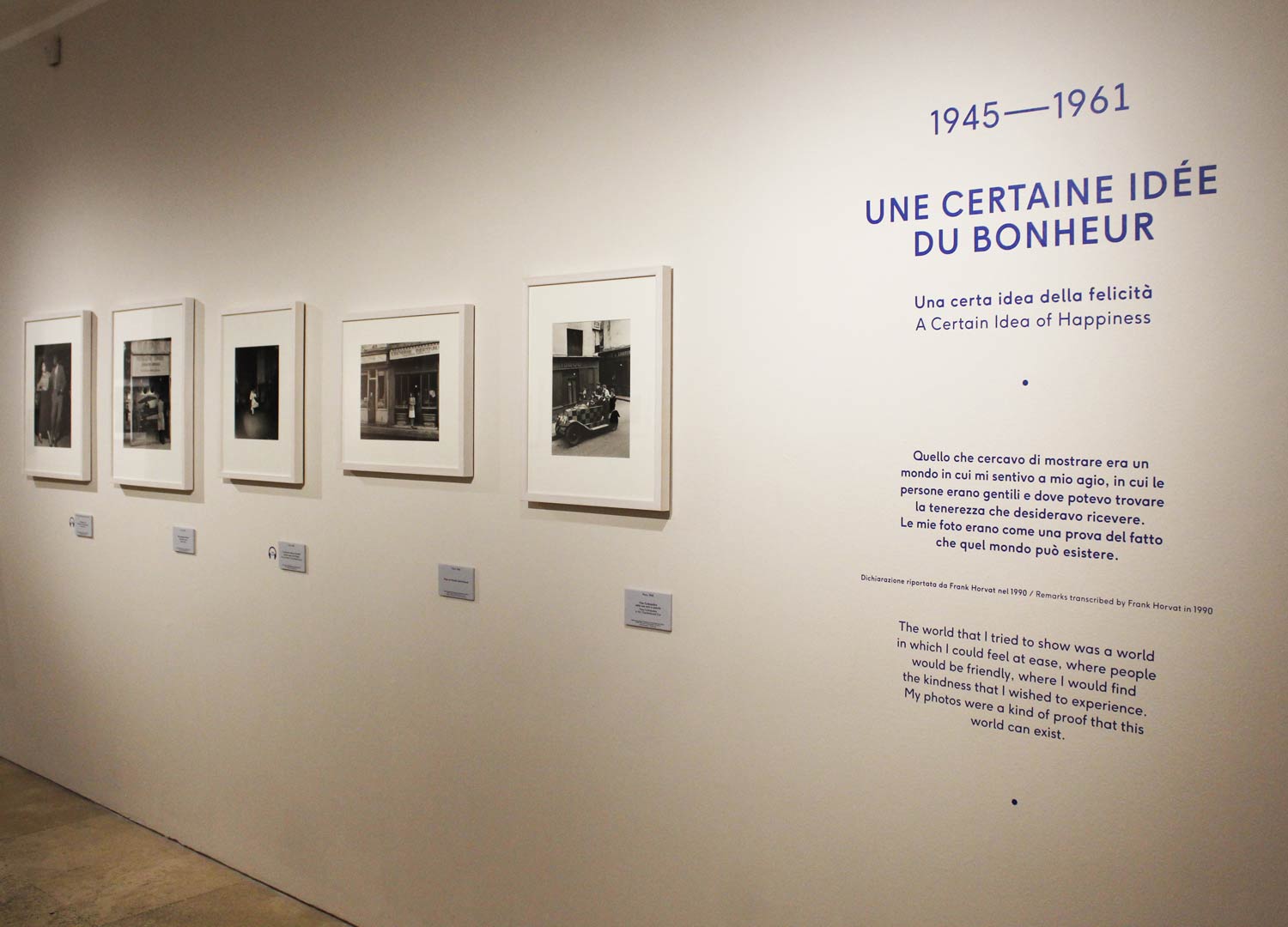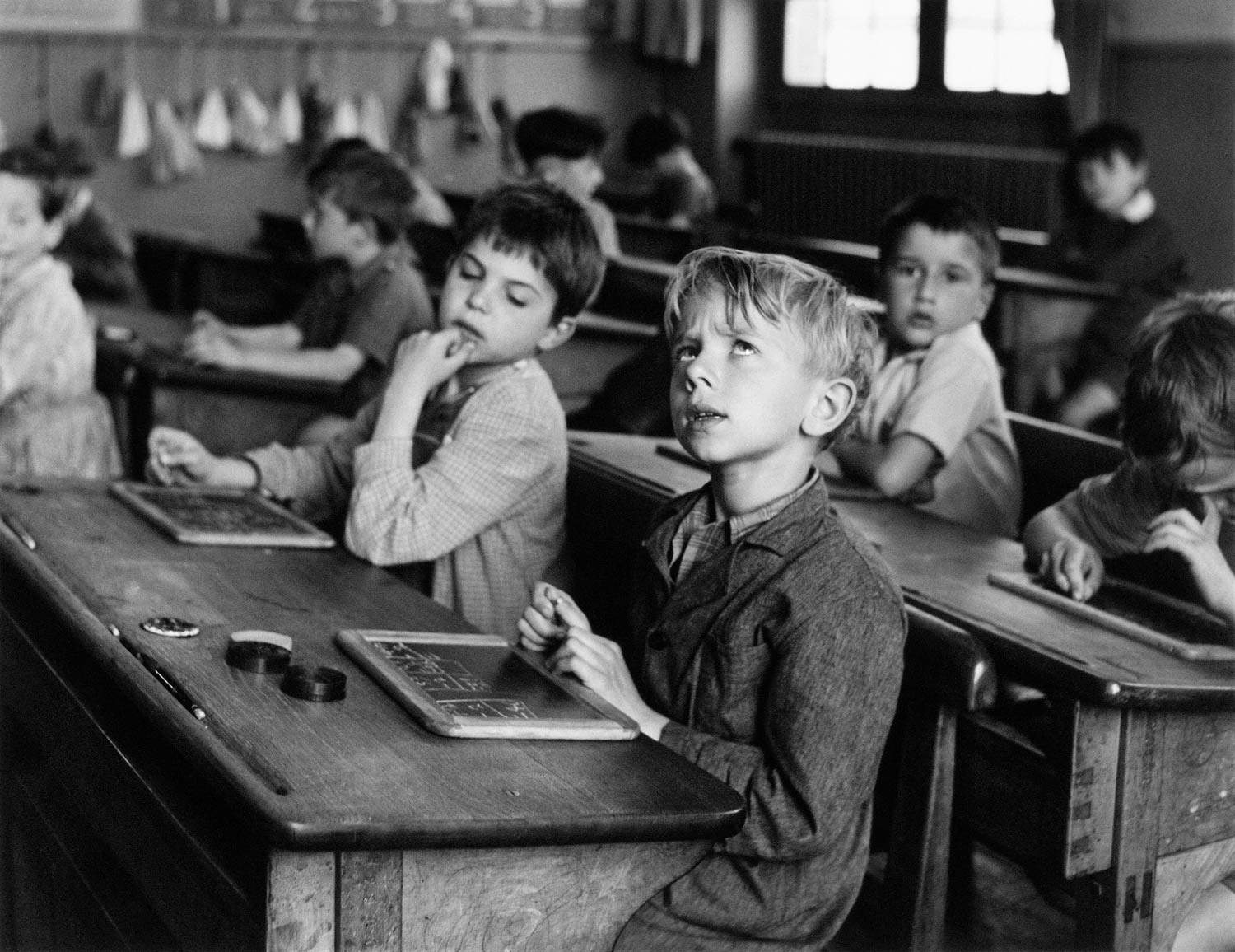The Robert Doisneau exhibition curated by Gabriel Bauret, produced by Roma Culture, Sovrintendenza Capitolina ai Beni Culturali, Fondazione Cassa di Risparmio di Padova e Rovigo and Silvana Editoriale, has landed in Rome, at the Ara Pacis Museum, and has already been a great success with the public in the past year at Palazzo Roverella in Rovigo and then at the Saint Benin Center in Aosta. A retrospective on the famous French photographer that brings together 130 images from the collection of Atelier Robert Doisneau in Montrouge, there where the photographer printed and archived his images for more than fifty years. If this note, reported by the press office, should make anyone approaching photography think that the works on display are original prints by the artist, it would be better to point out that this is not the case. This may be a disappointment, but it is quite common in large photography exhibitions, where what really matters is the curator’s narrative, which is therefore what this review will focus on.
If we judge by the number of exhibitions held in Italy, Doisneau is one of the most appreciated French photographers in our country. Only in Rome was the last one held at Palazzo delle Esposizioni in 2013, but in recent years there has been one in Bologna in 2020, one in Trieste in 2019, and one could continue at the same pace back in time. His fame is tied to his most famous photo, Le Baiser De L’Hotel De Ville (1950), which perhaps only on par with Alberto Korda’s portrait of Che Guevara, Guerrillero Heroico (1960), has graced the walls of generations of teenagers, decorated T-shirts, mugs and postcards. A couple kisses in the street, it is 1950, the war has just ended, and in this photo there is all the beauty of that moment: love, newfound serenity, optimism for the future. That is why it has become a symbolic photo of love, the romantic and passionate kind, sweet but also possessive. A love so addictive that it stops time in the instant of the kiss, while the world, behind the two protagonists, keeps moving. A photo so iconic that it did not lose its appeal even when it turned out in 1992 that the two lovers were merely actors, perhaps really in love, but nonetheless posed by Doisneau, who met them while making a reportage for Life magazine in Paris.







And perhaps the overabundant presence of this image in the collective memory has prevented a broader understanding of the work of Doisneau, who along with Henri Cartier-Bresson is considered one of the founding fathers of French humanist photography. Almost without ever moving from Paris, where he was born, he captured with his lens the daily lives of the men and women who populate the city and its suburbs, stopping the most ordinary gestures and making them universal narratives.
His quest is fascinating, almost utopian: to tell of beauty in small things, love, happiness accessible to all. “What I was trying to show was a world where I felt comfortable, where people were kind and where I could find the tenderness I longed to receive. My photos were like a proof that that world can exist”: so said Doisneau to Frank Horvat in an interview later reported in his 1990 book Entre Vues. A real challenge in years when photography had established itself for the great reportage of war and for how it had masterfully documented tragedy, misery, and death, thus creating an imagery always undergirded by a sense of pain and denunciation.
The exhibition begins with a detailed wall biography and statements of intent from the curator, who says on video that this “is not meant to be the usual retrospective.” Whether he succeeded in his intent or not, we will see at the end of the tour. Then we finally enter the exhibition area, where two parallel corridors open up. It may be that I didn’t notice the “exhibition route” sign, it may be that Western perceptual instincts automatically lead us to start from the left, but I take the wrong corridor and visit the exhibition all the way back like a salmon going upriver. I realize my mistake only after a while, because after all, this difference does not detract much from the experience of the visit since the exhibition is organized by autonomous thematic groups, and completely unrelated to each other.
There are the porters, from the Concierges series published in Vogue in 1949. Here I do not appreciate the panel that translates to Portinerie, instead of the more correct Portinai, because instead at the center of Doisneau’s research are always people, and only in the background their places. And this then is the only trait d ’union of the various parts of the exhibition. People at work are the protagonists of the Le monde du travail section, which collects photos taken by Doisneau in the Renault workshops for which he worked from 1934 to 1939 and of which he says “I learned about the world of those who wake up early.” In the Mode et mondanités section are the people of Parisian high society, whom Doisneau photographed in the service of Vogue in the years 1950 to 1952; a work he never loved and about which he says "very few of the pictures taken for Vogue stand the test of time. This proves that it was a misdirection."


These are people filmed in everyday life, ordinary people whom Doisneau elevates to the rank of protagonist of the story, thanks in part to his captions that give each the dignity of a precise identification: MadameTitine who camps on the quai de l’Arsenal(Madame Titine campe sur le quai de l’Arsenal, Paris, 1950), Monsieur Dubreuil who had an acacia in Bagnolet(L’Acacia de Monsieur Dubreuil, Bagnolet, 1957) and the inhabitants of the ruedu Transvaal (Les Habitants de la rue du Transvaal, Paris, 1953).
Doisneau’s first steps into photography are inexplicably placed in the middle of the course, where he reveals how he was rather intimidated by his chosen craft. “Daring to go out with a camera [...] in a rough place like the street, in contact with people,” reads his interview with Sylvain Roumette in 1983. And then with experience, if even the fear was gone, that gaze of his always remained at the right distance, it is respectful, never approaching beyond a half close-up, even in his commissioned portraits.
The panels do not help the overall reading, but they are an enjoyable collection of quotations from Doisneau and those who knew him, counterpointing excerpts from the documentary film Robert Doisneau. The Lens of Wonders by Clementine Deroudille, who, for the record, is Doisneau’s granddaughter, and perhaps thanks in part to this privileged access has succeeded in telling (much more than this exhibition) about the photographer’s aesthetics and thinking. And then, as if nothing had happened, the exhibition’s path reaches the war. An event so disruptive in the life of Europe and one that forced Doisneau to radically change the career path he had just embarked on. His photos of the war, here in the Occupation et libération section, are delicate, respectful, like no other photos we have seen of the war. The occupier is never seen, the scenes portrayed are those of life in the city of Paris, the suffering is there, but it is not explicit. And if Robert Capa taught us that "it’s not a good photo if you’re not close enough," Doisneau on the other hand shows that war can be told from afar: far from the front, far from the tragic death, among those left at home and still struggling to survive, but also far from the subject of the photo, respecting his pain, and returning to us today almost a sense of shame in having invaded such an intimate sphere.
In short, if we want to collect them, the elements of Doisneau’s aesthetic are all there: there is the attention to small things, the search for those moments of negligible happiness that also hold up a life. And the irony, subtle and biting, and so strong that it makes us smile even today when we look at L’Information scolaire, Paris, 1956 and recognize ourselves in that child sitting at the desk distracted and perhaps dreaming, or when in Un regard oblique, Paris, 1948 we see the instinct that escapes the control of convention. And then there are the details, always many, that allow one to discover something new in the pictures even when seeing them a thousand times.


Because Doisneau’s photos cannot be understood at first glance, without risking trivializing them by reading only the first of their thousands of meanings. And today we are so accustomed to being surrounded by images that we naturally resist looking longer, so there really is a need for a key that stimulates us to pay closer attention. What key? This is the challenge that should have been taken up by the curator who instead seems to be lulled by the easy success of a collection of beautiful images. In short, it seems that in the effort not to build the “usual retrospective,” the curator has built nothing. There is no common thread that can create the narrative of the exhibition (and to be sure, I even went over it in the correct direction!). Each chapter is untethered from the previous and the next, like those games where you have to find the meaning of a sequence. And I, even putting in so much effort, couldn’t find the meaning. Should it really be so difficult to understand an exhibition? In my opinion no, I think it should be a pleasant discovery even for those who have no tools to understand the hidden meanings, or the originality of the collection.
The real merit of this exhibition is the attention given to accessibility. In collaboration with the Omero State Tactile Museum, some of the works have been transformed into relief drawings intended for people with visual impairments. Besides being an admirable project, it has opened up a new perspective for me on the perception of the works. And if it weren’t for fear of ruining them and making them available to those who really need them, I would have dived in to touch that Baiser De L’Hotel De Ville done in relief, which even though I’ve already looked at a million times, to experience it by touch, to follow the contours of the protagonists, to touch those barely dotted areas that give back the idea of the blur.I would have liked to hear the audio descriptions, and I would be curious to attend the free tactile tours, guided by specialized operators.
Who knows, a more accessible world might teach us, the average person with sensory abilities, to discover new ones as well, to learn about the beauty around us in a different way. Too bad that road is still a long way off, and these tools are relegated to the role of “translating” works of art. If I may venture an idea for future exhibitions: let’s make art tactile, even for those who apparently do not need it. And so in the heat of this Roman summer, if you feel like being lulled by a bit of beauty, without paying too much attention to the substance of the story, but just to enjoy the coolness of air conditioning, then visit this exhibition open until September 4.
Warning: the translation into English of the original Italian article was created using automatic tools. We undertake to review all articles, but we do not guarantee the total absence of inaccuracies in the translation due to the program. You can find the original by clicking on the ITA button. If you find any mistake,please contact us.